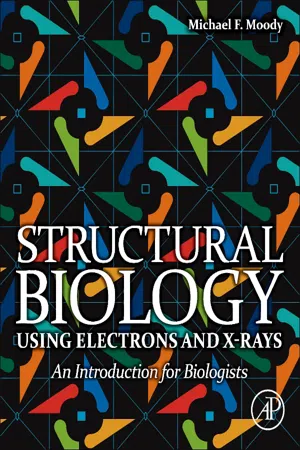
Structural Biology Using Electrons and X-rays
An Introduction for Biologists
- 450 pages
- English
- ePUB (mobile friendly)
- Available on iOS & Android
About This Book
Structural Biology Using Electrons and X-Rays discusses the diffraction and image-based methods used for the determination of complex biological macromolecules. The book focuses on the Fourier transform theory, which is a mathematical function that is computed to transform signals between time and frequency domain. Composed of five parts, the book examines the development of nuclear magnetic resonance (NMR), which allows the calculation of the images of a certain protein. Parts 1 to 4 provide the basic information and the applications of Fourier transforms, as well as the different methods used for image processing using X-ray crystallography and the analysis of electron micrographs. Part 5 focuses entirely on the mathematical aspect of Fourier transforms. In addition, the book examines detailed structural analyses of a specimen's symmetry (i.e., crystals, helices, polyhedral viruses and asymmetrical particles).
This book is intended for the biologist or biochemist who is interested in different methods and techniques for calculating the images of proteins using nuclear magnetic resonance (NMR). It is also suitable for readers without a background in physical chemistry or mathematics.
- Emphasis on common principles underlying all diffraction-based methods
- Thorough grounding in theory requires understanding of only simple algebra
- Visual representations and explanations of challenging content
- Mathematical detail offered in short-course form to parallel the text
Frequently asked questions
Information
Table of contents
- Cover Image
- Table of Contents
- Front-matter
- Copyright
- Preface
- Chapter 1. Overview
- Chapter 2. Correlations and Convolutions
- Chapter 3. Fourier Fundamentals
- Chapter 4. Digital Fourier Transforms
- Chapter 5. Filters
- Chapter 6. Two-Dimensional FTs
- Part II. Optics
- Chapter 7. Microscopy with Rays
- Chapter 8. Waves
- Chapter 9. Wave Imaging
- Chapter 10. Symmetry
- Chapter 11. Statistics and Matrices
- Chapter 12. The Third Dimension
- Part IV. Symmetry-Based Methods
- Chapter 13. X-Ray Crystallography
- Chapter 14. Crystalline Sheets
- Chapter 15. Helices
- Chapter 16. Icosahedral Particles
- Chapter 17. Unsymmetrical (‘Single’) Particles
- Chapter 18. Distortion Correction
- Chapter 19. FT Mathematics
- Chapter 20. Elementary Matrices
- References
- Index